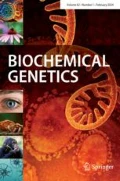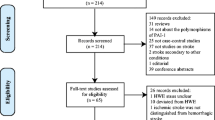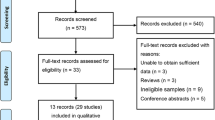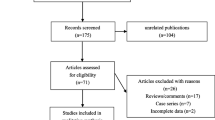Abstract
A systematic review and meta-analysis were conducted to find out if there was association between Plasminogen Activator Inhibitor-1 (PAI-1) gene polymorphisms (− 844 G > A and − 675 4G > 5G) and susceptibility to coronary artery disease (CAD). Search of electronic databases was performed and the pooled odds ratio (OR) and 95% confidence interval (CI) were exerted to evaluate the pooled association between the single-nucleotide polymorphisms (SNPs) and risk of CAD. For − 675 4G > 5G SNP, dominant (OR = 0.90), recessive (OR = 0.90), allelic (OR = 0.91), homozygous (OR = 0.84), and heterozygous (OR = 0.96) models were significantly associated with decreased risk of CAD. Moreover, all five genetic models were associated significantly with decreased CAD risk in the Causation and Arab populations. The results in Asians were marginally significant in recessive, allelic, and homozygote models. The male gender was found to be a risk factor in individuals with PAI-1 4G > 5G SNP in the dominant model (OR = 0.89), recessive model (OR = 0.91), allelic model (OR = 0.92), homozygous model (OR = 0.86), and heterozygous model (OR = 0.91). The results of pooled ORs for overall populations and subgroup analysis by ethnicity reject any association between PAI-1 gene − 844 G > A polymorphism and CAD risk under all genetic comparisons. The results of this meta-analysis indicated that PAI-1 4G > 5G SNP was associated with decreased risk of CAD in the overall population as well as in the Asians, Caucasians, and Arab populations. However, the PAI-1 gene − 844 G > A polymorphism had no significant association with susceptibility to CAD.








Similar content being viewed by others
Change history
12 October 2023
The original online version of this article was revised: The affiliation of the author Seyedeh Samaneh Tabaee has been corrected.
References
Abd El-Aziz TA, Rezk NA (2015) Relation of PAI-1 and TPA genes polymorphisms to acute myocardial infarction and its outcomes in Egyptian patients. Cell Biochem Biophys 71:227–234
Agirbasli M, Guney A, Ozturhan H, Agirbasli D, Ulucan K, Sevinc D, Kirac D, Ryckman K, Williams S (2011) Multifactor dimensionality reduction analysis of MTHFR, PAI-1, ACE, PON1, and eNOS gene polymorphisms in patients with early onset coronary artery disease. Eur J Cardiovasc Prev Rehabil 18:803–809
Ahmed W, Malik M, Saeed I, Khan AA, Sadeque A, Kaleem U, Ahmed N, Ajmal M, Azam M, Qamar R (2011) Role of tissue plasminogen activator and plasminogen activator inhibitor polymorphism in myocardial infarction. Mol Biol Rep 38:2541–2548
Alkhiary W, Azzam H, Yossof MMA, Aref S, Othman M, El-Sharawy S (2016) Association of hemostatic gene polymorphisms with early-onset ischemic heart disease in Egyptian patients. Clin Appl Thromb Hemost 22:535–542
Atherosclerosis, Thrombosis, and Vascular Biology Italian Study Group (2003) No evidence of association between prothrombotic gene polymorphisms and the development of acute myocardial infarction at a young age. Circulation 107:1117–1122
Begg CB, Mazumdar M (1994) Operating characteristics of a rank correlation test for publication bias. Biometrics 50:1088–1101
Beneš P, Mužík J, Benedík J, Frélich M, Elbl L, Vašků A, Znojil V, Vácha J (2000) Single effects of apolipoprotein B,(a), and E polymorphisms and interaction between plasminogen activator inhibitor-1 and apolipoprotein (a) genotypes and the risk of coronary artery disease in Czech male caucasians. Mol GenetMetab 69:137–143
Bicakcigil M, Tasan D, Tasdelen N, Mutlu N, Yavuz S (2011) Role of fibrinolytic parameters and plasminogen activator inhibitor 1 (PAI-1) promoter polymorphism on premature atherosclerosis in SLE patients. Lupus 20:1063–1071
Canavy I, Henry M, Morange P, Tiret L, Poirier O, Ebagosti A, Bory M, Juhan-Vague IJT (2000) Genetic polymorphisms and coronary artery disease in the south of France. Thromb Haemost 83:212–216
Conkbayir C, Gencer P, Barin B, Yucel G, Yildiz C, Ugurlucan M, Basak A (2017) Impact of Genetic Defects on Coronary Atherosclerosis among Turkish Cypriots. Heart Surg Forum. https://doi.org/10.1532/hsf.1587
Cortellaro M, Cofrancesco E, Boschetti C, Mussoni L, Donati M, Cardillo M, Catalano M, Gabrielli L, Lombardi B, Specchia G (1993) Increased fibrin turnover and high PAI-1 activity as predictors of ischemic events in atherosclerotic patients. A case-control study. The PLAT Group. Arterioscler Thromb 13:1412–1417
Dawson S, Hamsten A, Wiman B, Henney A, Humphries S (1991a) Genetic variation at the plasminogen activator inhibitor-1 locus is associated with altered levels of plasma plasminogen activator inhibitor-1 activity. Arterioscler Thromb 11:183–190
Dawson S, Hamsten A, Wiman B, Henney A, Humphries S (1991) Genetic variation at the plasminogen activator inhibitor-1 locus is associated with altered levels of plasma plasminogen activator inhibitor-1 activity. Arterioscler Thromb 11:183–190
DerSimonian R, Laird N (1986) Meta-analysis in clinical trials. Control Clin Trials 7:177–188
Diamanti-Kandarakis E, Palioniko G, Alexandraki K, Bergiele A, Koutsouba T, Bartzis M (2004) The prevalence of 4G5G polymorphism of plasminogen activator inhibitor-1 (PAI-1) gene in polycystic ovarian syndrome and its association with plasma PAI-1 levels. Eur J Endocrinol 150:793–798
Doggen CJM, Bertina R, Cats VM, Reitsma P, Rosendaal F (1999) The 4G/5G polymorphism in the plasminogen activator inhibitor-1 gene is not associated with myocardial infarction. Thromb Haemost 82:115–120
Egger M, Smith GD, Schneider M, Minder C (1997) Bias in meta-analysis detected by a simple, graphical test. BMJ 315:629–634
Eriksson P, Kallin B, Van’t Hooft FM, Båvenholm P, Hamsten A (1995) Allele-specific increase in basal transcription of the plasminogen-activator inhibitor 1 gene is associated with myocardial infarction. Proc Natl Acad Sci 92:1851–1855
Evans A, van Baal GCM, McCarron P, deLange M, Soerensen TI, De Geus EJ, Kyvik K, Pedersen NL, Spector TD, Andrew T (2003) The genetics of coronary heart disease: the contribution of twin studies. Twin Res Hum Genet 6:432–441
Fawzy MS, Toraih EA, Aly NM, Fakhr-Eldeen A, Badran DI, Hussein M (2017) Atherosclerotic and thrombotic genetic and environmental determinants in Egyptian coronary artery disease patients: a pilot study. BMC Cardiovasc Disord 17:1–19
García-González IJ, Valle Y, Sandoval-Pinto E, Valdés-Alvarado E, Valdez-Haro A, Francisco Munoz-Valle J, Flores-Salinas HE, Figuera-Villanueva LE, Dávalos-Rodríguez NO, Padilla-Gutiérrez JR (2015) The-844 G> A PAI-1 polymorphism is associated with acute coronary syndrome in Mexican population. Dis Markers. https://doi.org/10.1155/2015/460974
Gardemann A, Lohre J, Katz N, Tillmanns H, Hehrlein FW, Haberbosch W (1999) The 4G4G genotype of the plasminogen activator inhibitor 4G/5G gene polymorphism is associated with coronary atherosclerosis in patients at high risk for this disease. Thromb Haemost 82:1121–1126
Giannakoulas G, Dimopoulos K, Engel R, Goktekin O, Kucukdurmaz Z, Vatankulu MA, Bedard E, Diller GP, Papaphylactou M, Francis DP (2009) Burden of coronary artery disease in adults with congenital heart disease and its relation to congenital and traditional heart risk factors. Am J Cardiol 103:1445–1450
Grancha S, Estelles A, Tormo G, Falco C, Gilabert J, Espana F, Cano A, Segui R, Aznar J (1999) Plasminogen activator inhibitor-1 (PAI-1) promoter 4G/5G genotype and increased PAI-1 circulating levels in postmenopausal women with coronary artery disease. Thromb Haemost 81:516–521
Grubic N, Stegnar M, Peternel P, Kaider A, Binder BR (1996) A novel G/A and the 4G/5G polymorphism within the promoter of the plasminogen activator inhibitor-1 gene in patients with deep vein thrombosis. Thromb Res 84:431–443
Haselbauer A, Haberbosch W, Tillmanns H, Gardemann A (2002) The impact of the PAI-1 A (-844) G promoter polymorphism on the risk and extent of coronary heart disease. Thromb Haemost 88:697–698
Hassanzadeh-Makoui Reza, Razi Bahman, Aslani Saeed, Imani Danyal, Tabaee Seyedeh Samaneh (2020) The association between Matrix Metallo-proteinases-9 (MMP-9) gene family polymorphisms and risk of Coronary Artery Disease (CAD): a systematic review and meta-analysis. BMC Cardiovasc Disord 20:1–15
Hindorff LA, Schwartz SM, Siscovick DS, Psaty BM, Longstreth W Jr, Reiner AP (2002) The association of PAI-1 promoter 4G/5G insertion/deletion polymorphism with myocardial infarction and stroke in young women. Eur J Prev Cardiol 9:131–137
Hubacek JA, Staněk V, Gebauerová M, Pilipčincová A, Poledne R, Aschermann M, Skalická H, Matoušková J, Kruger A, Pěnička M (2010) Lack of an association between connexin-37, stromelysin-1, plasminogen activator-inhibitor type 1 and lymphotoxin-alpha genes and acute coronary syndrome in Czech Caucasians. Exp Clin Cardiol 15:e52
Idrissi HH, Hmimech W, Diakite B, Korchi F, Baghdadi D, Habbal R, Nadifi S (2016) Association of G894T eNOS, 4G/5G PAI and T1131C APOA5 polymorphisms with susceptibility to myocardial infarction in Morocco. Meta Gene Meta Gene 9:56–61
Isordia-Salas I, Leaños-Miranda A, Sainz IM, Reyes-Maldonado E, Borrayo-Sánchez G (2009) Association of the plasminogen activator inhibitor-1 gene 4G/5G polymorphism with ST elevation acute myocardial infarction in young patients. Rev Esp Cardiol 62:365–372
Iwai N, Shimoike H, Nakamura Y, Tamaki S, Kinoshita M (1998) The 4G/5G polymorphism of the plasminogen activator inhibitor gene is associated with the time course of progression to acute coronary syndromes. Atherosclerosis 136:109–114
Karimian A, Farajnia S, Ghojazadeh M, Khaki-Khatibi F (2016) The association between PAI-1 gene promoter polymorphism and serum serpin E1, MDA, and Hs-CRP levels in coronary artery disease. Int Cardiovasc Res J. https://doi.org/10.17795/icrj-10(03)129
Kathiresan S, Gabriel SB, Yang Q, Lochner AL, Larson MG, Levy D, Tofler GH, Hirschhorn JN, O’Donnell CJ (2005) Comprehensive survey of common genetic variation at the plasminogen activator inhibitor-1 locus and relations to circulating plasminogen activator inhibitor-1 levels. Circulation 112:1728–1735
Koch W, Schrempf M, Erl A, Mueller JC, Hoppmann P, Schömig A, Kastrati A (2010) 4G/5G polymorphism and haplotypes of SERPINE1 in atherosclerotic diseases of coronary arteries. Thromb Haemost 103:1170–1180
Koch W, Schrempf M, Erl A, Mueller JC, Hoppmann P, Schömig A, Kastrati A (2010b) 4G/5G polymorphism and haplotypes of SERPINE1 in atherosclerotic diseases of coronary arteries. Thromb Haemost 103:1170–1180
Kohler HP, Stickland MH, Ossei-Gerning N, Carter A, Mikkola H, Grant PJ (1998) Association of a common polymorphism in the factor XIII gene with myocardial infarction. Thromb Haemost 59:8–13
Lee J-Y, Lee B-S, Shin D-J, Park KW, Shin Y-A, Kim KJ, Heo L, Lee JY, Kim YK, Kim YJ (2013) A genome-wide association study of a coronary artery disease risk variant. J Hum Genet 58:120–126
Li YY (2012) Plasminogen activator inhibitor-1 4G/5G gene polymorphism and coronary artery disease in the Chinese Han population: a meta-analysis. PLoS One. 7:e33511
Lusis AJ, Mar R, Pajukanta P (2004) Genetics of atherosclerosis. Annu Rev Genomics Hum Genet 5:189–218
Mack M, Gopal A (2016) Epidemiology, traditional and novel risk factors in coronary artery disease. Heart Fail Clin 12:1–10
Mantel N, Haenszel W (1959) Statistical aspects of the analysis of data from retrospective studies of disease. J Natl Cancer Inst 22:719–748
Martinelli N, Trabetti E, Pinotti M, Olivieri O, Sandri M, Friso S, Pizzolo F, Bozzini C, Caruso PP, Cavallari U (2008) Combined effect of hemostatic gene polymorphisms and the risk of myocardial infarction in patients with advanced coronary atherosclerosis. PLoS One 3:e1523
Martini C, Doggen CJM, Cavallini C, Rosendaal F, Mannucci P (2005) No effect of polymorphisms in prothrombotic genes on the risk of myocardial infarction in young adults without cardiovascular risk factors. J Thromb Haemost 3:177–179
Mayer B, Erdmann J, Schunkert H (2007) Genetics and heritability of coronary artery disease and myocardial infarction. Clin Res Cardiol 96:1–7
Mohammad AM, Othman GO, Saeed CH, Al Allawi S, Gedeon GS, Qadir SM, Al-Allawi NJBRN (2020) Genetic polymorphisms in early-onset myocardial infarction in a sample of Iraqi patients: a pilot study. BMC Res Notes 13:1–6
Moher David, Shamseer Larissa, Clarke Mike, Ghersi Davina, Liberati Alessandro, Petticrew Mark, Shekelle Paul, Stewart Lesley A (2015) Preferred reporting items for systematic review and meta-analysis protocols (PRISMA-P) 2015 statement. Syst Rev 4:1–9
Morange P, Henry M, Tregouet D, Granel B, Aillaud M, Alessi M, Juhan-Vague I (2000) The A− 844G polymorphism in the PAI-1 gene is associated with a higher risk of venous thrombosis in factor V Leiden carriers. Arterioscler Thromb Vasc Biol 20:1387–1391
Morange P, Saut N, Alessi M, Yudkin J, Margaglione M, Di Minno G, Hamsten A, Humphries S, Tregouet D, Juhan-Vague I (2007a) Association of plasminogen activator inhibitor (PAI)-1 (SERPINE1) SNPs with myocardial infarction, plasma PAI-1, and metabolic parameters: the HIFMECH study. Arterioscler Thromb Vasc Biol 27:2250–2257
Morange P, Saut N, Alessi M, Yudkin J, Margaglione M, Di Minno G, Hamsten A, Humphries S, Tregouet D, Juhan-Vague I (2007) Association of plasminogen activator inhibitor (PAI)-1 (SERPINE1) SNPs with myocardial infarction, plasma PAI-1, and metabolic parameters: the HIFMECH study. Arterioscler Thromb Vasc 27:2250–2257
Musunuru K, Kathiresan S (2019) Genetics of common, complex coronary artery disease. Cell 177:132–145
Nakai K, Habano W, Fujita T, Nakai K, Schnackenberg J, Kawazoe K, Suwabe A, Itoh C (2002) Highly multiplexed genotyping of coronary artery disease-associated SNPs using MALDI-TOF mass spectrometry. Hum Mutat 20:133–138
Nakai K, Oyanagi M, Hitomi J, Ogasawara K, Inoue T, Kobayashi M, Nakai K, Suwabe A, Habano W, Baba T (2007) Screening the single nucleotide polymorphisms in patients with internal carotid artery stenosis by oligonucleotide-based custom DNA array. Bioinform Biol Insights 1:117793220700100000
Nikolopoulos GK, Bagos PG, Tsangaris I, Tsiara CG, Kopterides P, Vaiopoulos A, Kapsimali V, Bonovas S, Tsantes AE (2014) The association between plasminogen activator inhibitor type 1 (PAI-1) levels, PAI-1 4G/5G polymorphism, and myocardial infarction: a Mendelian randomization meta-analysis. Clin Chem Lab Med 52:937–950
Okrainec K, Banerjee DK, Eisenberg MJ (2004) Coronary artery disease in the developing world. Am Heart J 148:7–15
Onalan O, Balta G, Oto A, Kabakci G, Tokgozoglu L, Aytemir K, Altay C, Gurgey A, Nazli N (2008) Plasminogen activator inhibitor-1 4G4G genotype is associated with myocardial infarction but not with stable coronary artery disease. J Thromb Thrombolysis 26:211–217
Onrat ST, Akci Ö, Söylemez Z, Onrat E, Avşar A (2012a) Prevalence of myocardial infarction polymorphisms in Afyonkarahisar, Western Turkey. Mol Biol Rep 39:9257–9264
Onrat ST, Akci Ö, Söylemez Z, Onrat E, Avşar A (2012b) Prevalence of myocardial infarction polymorphisms in Afyonkarahisar, Western Turkey. Mol Biol Rep 39:9257–9264
Ortlepp JR, Lauscher J, Janssens U, Minkenberg R, Hanrath P, Hoffmann R (2002) Analysis of several hundred genetic polymorphisms may improve assessment of the individual genetic burden for coronary artery disease. Eur J Intern Med 13:485–492
Park HS, Sung J-H, Ryu CS, Lee JY, Ko EJ, Kim IJ, Kim NK (2020) The Synergistic Effect of Plasminogen Activator Inhibitor-1 (PAI-1) Polymorphisms and Metabolic Syndrome on Coronary Artery Disease in the Korean Population. J Pers Med 10:257
Pastinen T, Perola M, Niini P, Terwilliger J, Salomaa V, Vartiainen E, Peltonen L, Syvänen A-C (1998) Array-based multiplex analysis of candidate genes reveals two independent and additive genetic risk factors for myocardial infarction in the Finnish population. Hum Mol Genet 7:1453–1462
Pepper MS (2001) Role of the matrix metalloproteinase and plasminogen activator–plasmin systems in angiogenesis. Arterioscler Thromb Vasc Biol 21:1104–1117
Petrovič D, Globočnik-Petrovič M, Peterlin B (2003) 4G4G genotype of PAI-1 gene promoter polymorphism is not associated with myocardial infarction in Caucasians with type-2 diabetes. Cardiology 100:157–158
Pournima P, Abirami SB, Devi A, ArulJothi K (2018) Association of Plasminogen Activator Inhibitor-1 (PAI-1) 4G/5G and Apolipoprotein E polymorphisms with risk of Myocardial Infarction in Indian Tamil Population. Res J Biotechnol 13:1
Rallidis LS, Gialeraki A, Merkouri E, Liakos G, Dagres N, Sionis D, Travlou A, Lekakis J, Kremastinos DT (2010) Reduced carriership of 4G allele of plasminogen activator inhibitor-1 4G/5G polymorphism in very young survivors of myocardial infarction. J Thromb Thrombolysis 29:497–502
Sakhteh Maryam, Poopak Behzad, Amirizadeh Naser, Shamshiri Ahmadreza, Bagheri Abdolhamid, Faranoush Mohammad (2015) Polymorphism and synergism of angiotensin-converting enzyme (ACE) and plasminogen activator inhibitor-1 (PAI-1) genes in coronary artery disease. J Renin Angiotensin Aldosterone Syst 16:1168–1174
Sanjadi M, Rezvanie Sichanie Z, Totonchi H, Karami J, Rezaei R, Aslani S (2018) Atherosclerosis and autoimmunity: a growing relationship. Int J Rheum Dis 21:908–921
Sarecka B, Zak I, Krauze J (2008) Synergistic effects of the polymorphisms in the PAI-1 and IL-6 genes with smoking in determining their associated risk with coronary artery disease. Clin Biochem 41:467–473
Senol S, Es MU, Gokmen G, Ercin O, Tuylu BA, Kargun K, Annals T (2015) Genetic polymorphisms in preoperative myocardial infarction. Asian Cardiovasc Thorac Ann 23:389–393
Sharma K, Gulati M (2013) Coronary artery disease in women: a 2013 update. Glob Heart 8:105–112
Sobel BE (1999) Increased plasminogen activator inhibitor-1 and vasculopathy: a reconcilable paradox. Circulation 99:2496–2498
Stang A (2010) Critical evaluation of the Newcastle-Ottawa scale for the assessment of the quality of nonrandomized studies in meta-analyses. Eur J Epidemiol 25:603–605
Stegnar M, Uhrin P, Peternel P, Mavri A, Salobir-Pajnič B, Stare J, Binder BR (1998) The 4G/5G sequence polymorphism in the promoter of plasminogen activator inhibitor-1 (PAI-1) gene: relationship to plasma PAI-1 level in venous thromboembolism. Thromb Haemost 79:975–979
Su S, Chen S, Zhao J, Huang J, Wang X, Chen R, Gu D (2006) Plasminogen activator inhibitor-1 gene: selection of tagging single nucleotide polymorphisms and association with coronary heart disease. ATVB 26:948–954
Takeuchi F, Yokota M, Yamamoto K, Nakashima E, Katsuya T, Asano H, Isono M, Nabika T, Sugiyama T, Fujioka A (2012) Genome-wide association study of coronary artery disease in the Japanese. Eur J Hum Genet 20:333–340
Tàssies D, Roqué M, Monteagudo J, Martorell T, Sionis A, Arzamendi D, Heras M, Reverter J-C (2009) Thrombin-activatable fibrinolysis inhibitor genetic polymorphisms as markers of the type of acute coronary syndrome. Thrombosis Res 124:614–618
Tobin MD, Braund PS, Burton PR, Thompson JR, Steeds R, Channer K, Cheng S, Lindpaintner K, Samani NJ (2004) Genotypes and haplotypes predisposing to myocardial infarction: a multilocus case-control study. Eur Heart J 25:459–467
Whiting BM, Anderson JL, Muhlestein JB, Horne BD, Bair TL, Pearson RR, Carlquist JF (2005) Candidate gene susceptibility variants predict intermediate end points but not angiographic coronary artery disease. Ame Heart J 150:243–250
Yalım Z, Onrat ST, Emren SV, Dural İE, Avşar A, Onrat E (2020) Analysis of thrombophilic gene mutations in coronary artery ectasia. Turk Kardiyol Dern Ars 48:368–373
Żak I, Balcerzyk A, Sarecka B, Niemiec P, Ciemniewski Z, Dyląg S (2005) Contemporaneous carrier-state of two or three “proatherosclerotic” variants of APOE, ICAM1, PPARA and PAI-1 genes differentiate CAD patients from healthy individuals. Clin Chim Acta 362:110–118
Zhang AY, Ji XW, Zhang AJ, Guan LX, Huang J, Wang J (2010) Role of genetic polymorphism of angiotensin-converting enzyme, plasminogen activator inhibitor-1 and endothelial nitric oxide synthase in the prognosis of coronary artery disease. Cardiol Res 1:8
Zhang H, Dong P, Yang X, Liu Z (2014) Plasminogen activator inhibitor-1 4G/5G polymorphism is associated with coronary artery disease risk: a meta-analysis. Int J Clin Exp Med 7:3777–3788
Zorio E, Gilabert-Estellés J, Espana F, Ramon LA, Cosin R, Estelles A (2008) Fibrinolysis: the key to new pathogenetic mechanisms. Curr Med Chem 15:923–929
Acknowledgements
The authors are grateful of Deputy of Research from Neyshabur University of Medical Science.
Author information
Authors and Affiliations
Corresponding author
Ethics declarations
Conflict of interest
None.
Additional information
Publisher's Note
Springer Nature remains neutral with regard to jurisdictional claims in published maps and institutional affiliations.
Supplementary Information
Below is the link to the electronic supplementary material.
Rights and permissions
Springer Nature or its licensor (e.g. a society or other partner) holds exclusive rights to this article under a publishing agreement with the author(s) or other rightsholder(s); author self-archiving of the accepted manuscript version of this article is solely governed by the terms of such publishing agreement and applicable law.
About this article
Cite this article
Tabaei, S., Omraninava, M., Mehranfar, S. et al. Plasminogen Activator Inhibitor-1 Polymorphisms and Risk of Coronary Artery Disease: Evidence From Meta-Analysis and Trial Sequential Analysis. Biochem Genet 60, 1409–1445 (2022). https://doi.org/10.1007/s10528-021-10143-x
Received:
Accepted:
Published:
Issue Date:
DOI: https://doi.org/10.1007/s10528-021-10143-x




